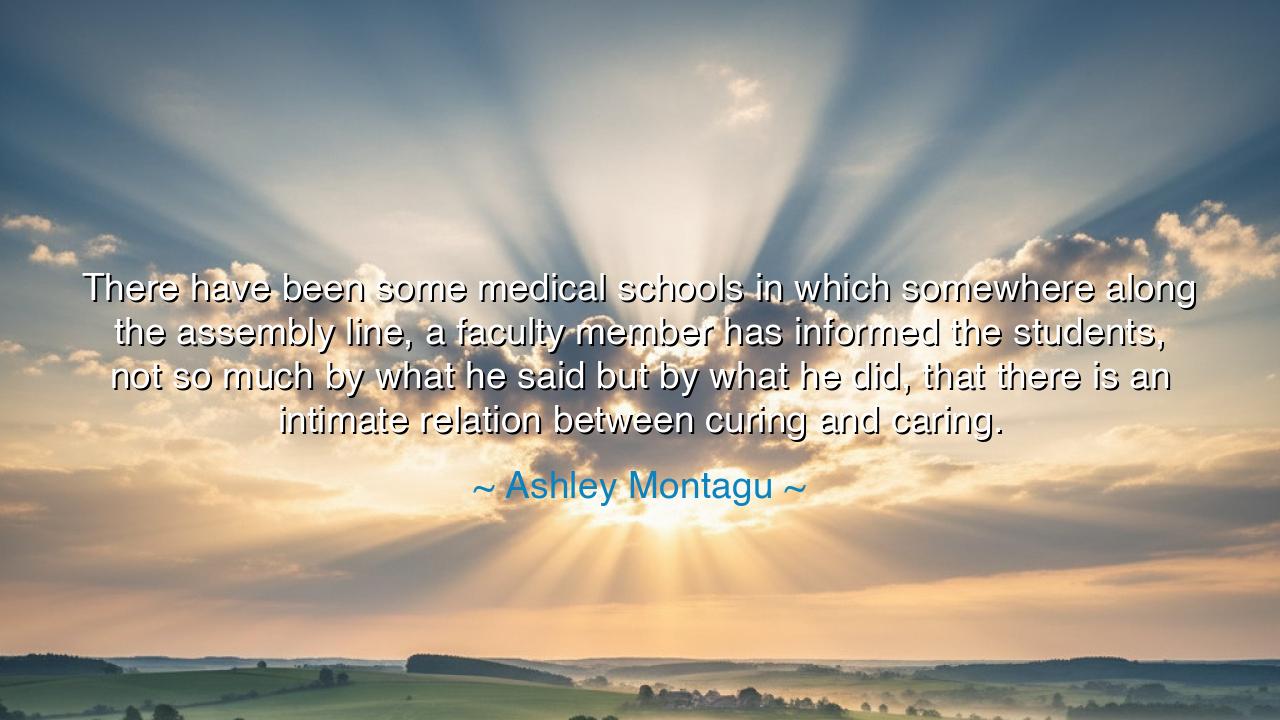
There have been some medical schools in which somewhere along the
There have been some medical schools in which somewhere along the assembly line, a faculty member has informed the students, not so much by what he said but by what he did, that there is an intimate relation between curing and caring.






"There have been some medical schools in which somewhere along the assembly line, a faculty member has informed the students, not so much by what he said but by what he did, that there is an intimate relation between curing and caring." With these words, Ashley Montagu speaks to a deeper truth about the practice of medicine—a truth that reaches beyond the mere application of medical knowledge and touches the very essence of what it means to heal. In Montagu’s reflection, we find that caring is not a supplementary aspect of curing; it is an integral, inseparable part of it. Curing may mend the body, but it is caring that heals the spirit, that nurtures the connection between patient and healer, and that transforms the act of healing into a truly humane endeavor.
In ancient times, the healers were not merely practitioners of physical remedies but were also regarded as guardians of the soul. The Asclepiads, followers of Asclepius, the ancient Greek god of medicine, understood that healing required more than just the application of herbs or surgery. In their sacred temples, known as Asclepiions, the physical treatments were coupled with rituals, prayers, and compassionate care to ease the suffering of the patient’s mind. It was believed that the soul and body were intrinsically linked, and to heal one without considering the other was an incomplete and hollow approach. The very notion of caring as part of curing can be traced to these ancient practices, where the holistic nature of healing was understood long before the advent of modern medicine.
Montagu’s words echo a sentiment shared by the great healers and philosophers of old. Hippocrates, the father of modern medicine, not only taught the science of healing the body but also emphasized the importance of the physician’s character and ethics. He counseled that the healer must treat the whole person, not just the symptoms. “Wherever the art of medicine is loved, there is also a love of humanity,” Hippocrates wrote. This love of humanity, this deep-seated respect and care for the individual, was seen as the foundation of true medical practice. To heal with compassion and empathy was to recognize the patient’s humanity, to understand that healing was not a transaction of knowledge but a sacred duty that demanded the utmost respect for life itself.
Montagu also draws attention to a disturbing reality—that in some medical institutions, caring can be lost in the mechanized, clinical nature of curing. The idea of the assembly line, where students are trained to view patients as mere cases or conditions to be solved, is a warning against the dehumanization that can occur when medicine becomes too focused on technique and procedure. The ancient Egyptians, while masters of surgical practice, also recognized the healer’s role in comforting and restoring the soul. They believed that the power of empathy was crucial to their medical art, and the healer was to be a companion to the sick, a guide to the weary. This view maintained that medicine was not just a science but a sacred vocation, where the act of caring was seen as equally essential to the act of curing.
There are countless stories in the modern era that show us how healing is truly a union of curing and caring. One such story is that of Dr. Paul Farmer, the renowned physician and anthropologist who co-founded Partners In Health. Dr. Farmer’s work in Haiti and other underserved parts of the world is a shining example of how medical care and compassionate care go hand in hand. In his work, he consistently emphasized that curing diseases was not enough—one must also care for the human being who suffers. Dr. Farmer treated his patients with deep respect and empathy, always working not just to cure their illnesses, but to lift their spirits and improve their lives. Through his example, we learn that caring is not just an emotion; it is a force that empowers the patient and the healer alike.
The essential lesson in Montagu’s words is that medicine must be practiced with heart and humanity. Caring is not an afterthought to curing; it is the very core of healing. The doctor-patient relationship is not just transactional—it is a deeply personal bond, one built on mutual trust, respect, and a shared commitment to the patient’s well-being. As we consider this wisdom, we must also ask ourselves how we approach the practice of medicine—whether as caregivers or as patients. Do we, too, recognize the importance of caring in the process of healing, or do we reduce it to a mere exchange of knowledge and remedies?
In our own lives, let us carry this lesson forward: to cure without caring is to fall short of true healing. Whether in our work, in our families, or in our communities, let us strive to embody the principle that caring is as essential as curing. For it is through our care, our compassion, and our commitment to the human spirit that we can truly bring healing to the world. Let us become healers in the fullest sense, recognizing the intimate relation between curing and caring, and by doing so, create a world where the heart of medicine is as vital as its science.






AAdministratorAdministrator
Welcome, honored guests. Please leave a comment, we will respond soon